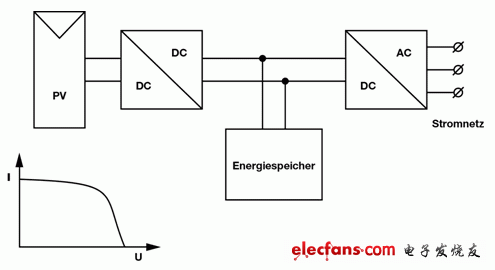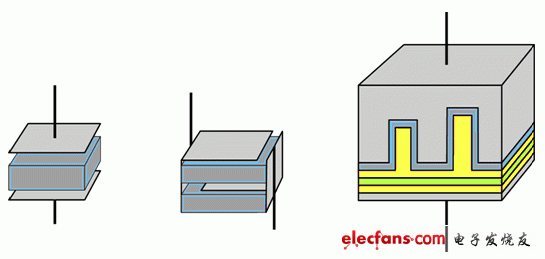Foreword
Solar inverters play an interface between solar panels and the main grid. As shown in Figure 1, two power conversion processes take place inside the solar inverter. A DC/DC converter controls the operating point of the solar panel to achieve maximum power output. The DC/AC converter delivers this portion of the power to the main grid while performing various control rules established by the main grid operator. The energy buffer absorbs the difference in power flow between the two converters. Successful implementation of this process depends to a large extent on the capacitor you choose for the energy buffer. This article describes how trade-offs between film capacitors and aluminum capacitors are made, as well as factors you need to consider when choosing one or the other capacitor.

Figure 1: Solar inverter block diagram: solar panel and U/I characteristics, DC/DC, energy buffer, DC/AC, mains grid
Preliminary considerations
By installing an energy buffer, you can take the maximum power from the solar panel separately, and how to inject this energy into the main transmission and distribution system. Moreover, doing so will reduce the complexity of the design.
The size of the energy buffer is determined by how much energy needs to be stored. The amount of energy depends on the power level of the solar inverter and the length of time between the two processes of storing and releasing energy. For reference, if the time difference is less than 1 second, there is no problem in using a film capacitor or an aluminum capacitor. If the time is more than 1 second, you should consider using an electrochemical double layer capacitor or battery pack. But both technologies require a voltage between 1V and 4V per cell. The higher voltage levels required to connect to the mains grid require several batteries to be connected in series, so it is necessary to add electronics to maintain balance. Since the drive battery or electrochemical double layer capacitor unit has some special requirements, this function is usually implemented by a separate power electronic module. The detailed description of the module is beyond the scope of this paper.
Film capacitors and aluminum capacitors have some usage limitations that affect the service life and reliability of solar inverters. Therefore, you need to detail the changes under long-term working conditions. The important parameters are the device ambient temperature, operating voltage, ripple current and duration. Table 1 gives an example of a very simple working situation.

Table 1: Simple examples of working conditions
Capacitor basics
Thin films and aluminum capacitors are two types of capacitors that have evolved from parallel substrate capacitors. Figure 2 shows the basic structure of the two capacitors, marking the main differences.

Figure 2: Capacitor structure: parallel substrate, film capacitor, aluminum capacitor
Down Tube Battery,Ebike Lithium Battery,24V Bottle Battery,24V Electric Bicycle Battery
Changxing Deli Technology Co., Ltd. , https://www.delipowers.com